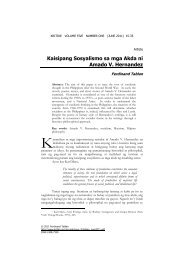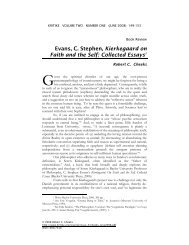The Paradox of Ipseity and Difference: Derrida's Deconstruction and ...
The Paradox of Ipseity and Difference: Derrida's Deconstruction and ...
The Paradox of Ipseity and Difference: Derrida's Deconstruction and ...
Create successful ePaper yourself
Turn your PDF publications into a flip-book with our unique Google optimized e-Paper software.
R. PADA 33<br />
<strong>of</strong> the author <strong>and</strong> its recipient, 4 which he aptly refers to as the economy <strong>of</strong><br />
difference. 5 Elsewhere, he also considers this economy to be the general system<br />
<strong>of</strong> similarity <strong>and</strong> difference taken as a singular account existing within the<br />
transaction between the self <strong>and</strong> its other, 6 it is an economy in which the text<br />
extends itself further in its repetition <strong>of</strong> itself through an other, <strong>and</strong> with it the<br />
limitations <strong>of</strong> its extensions becomes implied as it exp<strong>and</strong>s to the extents <strong>of</strong> its<br />
new iteration. <strong>The</strong> entirety <strong>of</strong> this activity for Derrida is already deconstructive.<br />
<strong>The</strong>re are various ways <strong>of</strong> defining or rather, describing the operations <strong>of</strong><br />
deconstruction: one <strong>of</strong> which is passive <strong>and</strong> the other is active. Both however,<br />
subscribes towards the alteration or the parasitism in which the contamination<br />
<strong>of</strong> the text is implied, for in a passive deconstruction, the “reader” merely<br />
applies the content <strong>of</strong> his or her bias in accordance to the structure <strong>of</strong> the text<br />
itself. <strong>The</strong> active variant <strong>of</strong> deconstruction, on the other h<strong>and</strong>, is a teasing out <strong>of</strong><br />
contradictions within the interplay <strong>of</strong> the text <strong>of</strong> an author’s work <strong>and</strong> its<br />
claims <strong>of</strong> presence; in seeing this contradictions within the text, the “reader” (or<br />
more fittingly, the writer) inserts his or her criticisms <strong>and</strong> alterations <strong>of</strong> the<br />
work, radically altering the text within its own enclosures <strong>and</strong> within the limits<br />
<strong>of</strong> the “reader’s” underst<strong>and</strong>ing <strong>of</strong> the text. Derrida’s works would usually fall<br />
into the second variant <strong>of</strong> deconstruction, for his criticisms involves an internal<br />
dissection <strong>of</strong> another author’s work itself, 7 which contrary to what critics<br />
would call “skeptical,” helps the discourse move further in the direction <strong>of</strong> its<br />
goals.<br />
Both <strong>of</strong> these variants <strong>of</strong> deconstruction concern themselves with the<br />
problem <strong>of</strong> repetition 8 <strong>and</strong>, in both cases, deconstruction has always subscribed<br />
to the economy <strong>of</strong> différance as far as repetition is concerned. In Dissemination,<br />
Derrida accounts for repetition as a severance from “good writing,” to which<br />
he comments Plato’s notion <strong>of</strong> writing:<br />
4 Derrida, Limited Inc., 74.<br />
5 Derrida would write this in the context <strong>of</strong> the transaction <strong>of</strong> identities made between<br />
the “I” <strong>and</strong> the “Other” in Levinas’ Totality <strong>and</strong> Infinity. Jacques Derrida, “Violence <strong>and</strong><br />
Metaphysics,” in Writing <strong>and</strong> <strong>Difference</strong>, trans. by A. Bass, (London: Routledge, 1978), 129.<br />
6 Jacques Derrida, Positions, trans. by A. Bass, (Chicago: University <strong>of</strong> Chicago Press,<br />
1981), 8-9.<br />
7 To note, Derrida’s deconstructive method is keen enough to observe a certain<br />
st<strong>and</strong>ard <strong>of</strong> rigor. Derrida’s deconstructions are <strong>of</strong>ten made on the account that he has read not<br />
only the work in question, but also the works <strong>of</strong> such authors <strong>and</strong> the other authors involved in<br />
the text. For example, in reading Levinas, Derrida takes as a context the entirety <strong>of</strong> the<br />
philosophemes involved with Levinas (i.e. Heidegger, Husserl, Judaism, Kierkegaard, etc.), <strong>and</strong><br />
not only this proves most <strong>of</strong> his points as sound <strong>and</strong> well thought <strong>of</strong>, it also opens the discourses<br />
that he deconstructs to further exploration <strong>and</strong> even application.<br />
8 Derrida employs several motifs that refers to repetition in which the effect <strong>of</strong><br />
différance becomes apparent. Among such motifs is the notion <strong>of</strong> mimesis <strong>and</strong> Mallarme’s<br />
mimodrama in Dissemination, in which the mime never really repeats the originary scene <strong>of</strong> the<br />
scene, but rather, recreates the scene with some relative sense <strong>of</strong> verisimilitude while at the same<br />
time retaining the unique taint <strong>of</strong> the mediation <strong>of</strong> an individuals ‘miming’ <strong>of</strong> scene or the<br />
‘appearing. <strong>The</strong> paradox that belongs to mimesis or repetition involves the indeterminable<br />
congruency <strong>and</strong> dissimilutation that exists in the relation <strong>of</strong> the copy from that <strong>of</strong> the original.
















